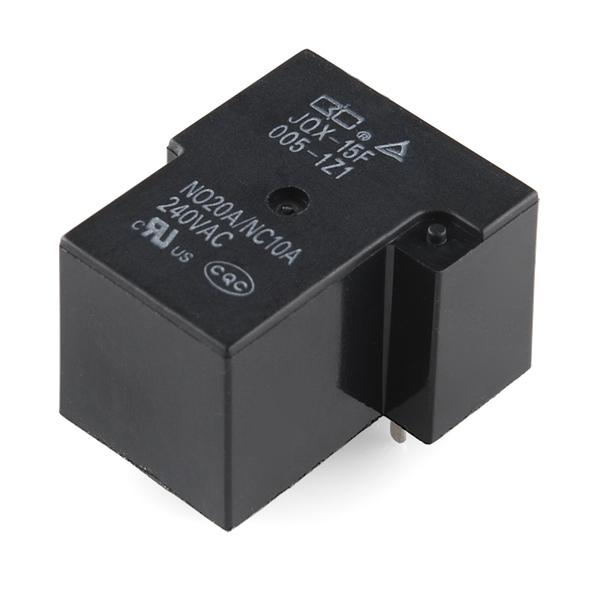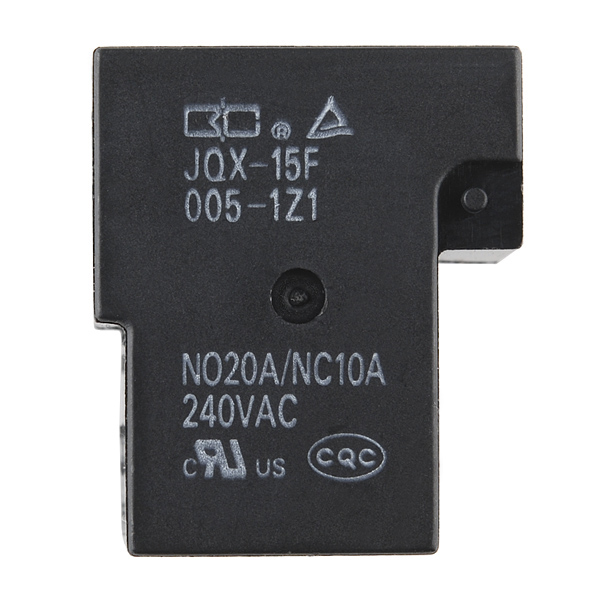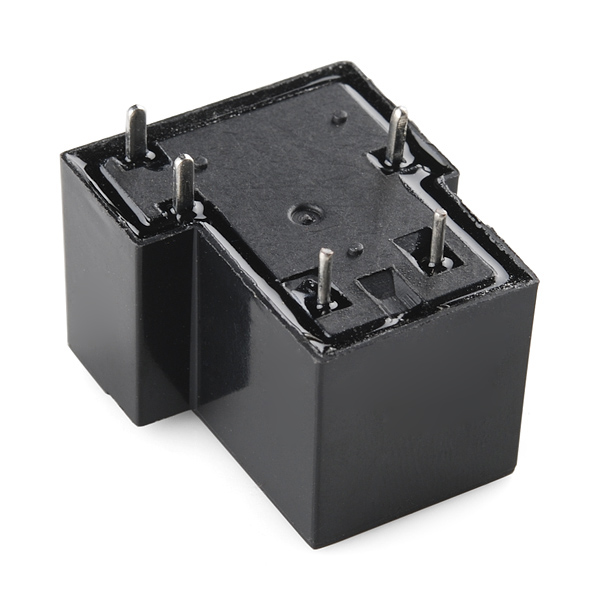These are massive single pole - double throw (SPDT) sealed relays. This means that when current is applied to the coil it throws a simple changeover switch, terminating the connection from the NC contact to ground and closing the NO contact. Use them to switch high voltage/high current devices.
- SPDT Relay
- Contacts Rated up to 220VAC @ 20A
- Coil Voltage: 5V
- Fully Sealed
- Datasheet (JQX-15F/005)
- Relay Tutorial
Relay SPDT Sealed - 20A Product Help and Resources
Core Skill: Soldering
This skill defines how difficult the soldering is on a particular product. It might be a couple simple solder joints, or require special reflow tools.
Skill Level: Noob - Some basic soldering is required, but it is limited to a just a few pins, basic through-hole soldering, and couple (if any) polarized components. A basic soldering iron is all you should need.
See all skill levels
Core Skill: Electrical Prototyping
If it requires power, you need to know how much, what all the pins do, and how to hook it up. You may need to reference datasheets, schematics, and know the ins and outs of electronics.
Skill Level: Competent - You will be required to reference a datasheet or schematic to know how to use a component. Your knowledge of a datasheet will only require basic features like power requirements, pinouts, or communications type. Also, you may need a power supply that?s greater than 12V or more than 1A worth of current.
See all skill levels
Comments
Looking for answers to technical questions?
We welcome your comments and suggestions below. However, if you are looking for solutions to technical questions please see our Technical Assistance page.
Customer Reviews
No reviews yet.




Man, my concept of what constitutes a big relay has been completely skewed: http://www.abb.com/product/seitp329/12daed844051a599482570f30045c9e5.aspx?tabKey=2&gid=ABB.ASEASK827045-EM
And, they get a lot bigger than that!
Ok, that's a fun one.
These are great relays, but IMNSHO, not so great for hobbyists on account of their closely-spaced PCB contact pins. Getting the most safety and performance requires a knowledge of high-powered PCB and/or Breadboard design techniques. If you know what you're doing, that's great- but if, for instance, you are unfamiliar with the concept of creepage, or selecting the right gauge wire for an application, you can get into some trouble.
I think that a much more hobby-friendly device is something like this: http://www.mouser.com/Search/ProductDetail.aspx?R=T9AP1D52-12virtualkey65500000virtualkey655-T9AP1D52-12 This one is literally only a few cents more, and electrially identical, but use Faston connectors instead of PCB pins.
When it comes to building high-current/high-voltage circuits, point-to-point wiring is easier and safer to do with the tools available to the average hobbyist. I cringe when I see photos of kludgey-looking projects controlling things like heaters and air conditioners with sloppy and inadequate wiring and connections. Please consider offering a different version.
The same datasheet seems to cover both of these relays, and everything matches. I don't see what problem you are running into, rsp.
It's hard to tell what this really is because the pictures, part numbers, and data sheet don't match. Save yourself a headache by spending an extra dollar to buy the P/B name branded part (COM-00101) instead.
Hate to ask what appears to be a rather newbie question, but does the direction of current flow through the coil matter? I'm designing a PCB and simply want to be sure the polarity is not an issue.
polarity shouldn't be issue, at least all DC-operated relays i've used have accepted any polarity...if you place EMF-catch diode, that of course matters the polarity (old question i know)
I would like to use this in a three-way switch system, is there a way to accomplish this or should i get a different relay? What is the purpose of the other pin not used on the control board? Update: I finally got a continuity test from NC to COM, there was some stuff covering the pins blocking the signal
What reason might there be for a relay to "click" but not actually close the switch? Is it just a bad part?
the control voltage/current might be too too low so relay just tries to work but just don't work. Check with meter that contacts are like supposed in contact side. It could be just bad part, relay has already seen use, contacts sometimes ''lock'' or more to say melt together rarely. Then relay tries to operate but already has operated, it can be fixed by opening relay and carefully prying and smoothing contacts. But low voltage/current for coil is main issue that causes relay not work (again oldie....)
Are you using the relay control pcb?
These are rates for AC current, but what about DC? I'm thinking of building a railgun, which involves a lot of very big capacitors (on the order of 300v) going off in parallel, and I need something with which to switch them. Will this do the job?
EDIT: Nevermind, the datasheet says 28v, which is less than 1/10 of what I need. I'll keep looking.
Have you seen SSR-25DA? It lets 25A and you can get it for 5€: http://dx.com/es/p/ssr-25da-25a-solid-state-relay-white-134494
I got the link for this relay from reading the Sparkfun tutorial 'Controllable Power Outlets'. The relay in the tutorial is pictured with a control board containing resistor, LED, etc. Does Sparkfun sell this item with the board? Or do I have to buy that somewhere else?
The tutorial is pretty old, but the closest product we carry currently is the Beefcake Relay Kit.
I hate to be "That guy", but, EAGLE footprint number, por favor?
Looks like it should be: SparkFun-Electromechanical.lbr / Device: RELAY / Package: RELAY-T9A or RELAY-T9A2 (different outline)
Can this be mounted on a protoboard?
The correct datasheet for this relay is http://www.bcrelays.com/Relay.JQX-15F.pdf
I have a few of these and the coil operates at 5 volts. Almost like they planed for them to be used with an arduino. The data sheet is somewhat confusing because it cover many relays of this type.
Can you drive this directly from an Aruino?? It says power consumption is 0.9W @ 5.0V, that's 180mA, which exceeds the current capability of an Arduino port.
You cannot drive it directly from an Arduino, but you can add a transistor to the circuit. The Arduino activates the transistor, the transistor activates the relay. See the Relay Tutorial to see exactly how this is accomplished.
What is the maximum DC load it can handle?
What's the coil voltage? I checked the data sheet, but it describes a range of relays with coil voltages from 5VDC to 110VDC depending on the part number, and I don't see a number in the pictures that look like it matches the datasheet.
skimming thru the related products, i can see the first image matches http://www.sparkfun.com/products/101 exactly
looks like they just copied the image
00101 is the 30A version. Likely it's exactly the same in outward appearance, except for the numbers, but the 00101 is beefier on the inside